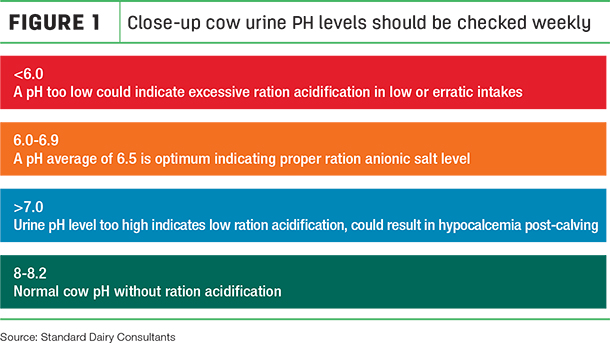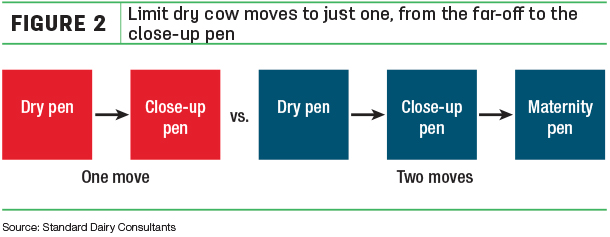Many of today’s dairy farms have become larger, often without increasing their labor force. The management systems successful on a smaller dairy will frequently evolve into a system no longer best for the cow.
When there is procedural drift, combined with or due to a dilution of labor resources, the details of dairy management aren’t evaluated as regularly, causing herd health issues, loss of production and, ultimately, lost profit.
Over the past 25 years in my experience as a dairy nutrition consultant, one thing has consistently remained the most important and difficult part of the job: feeding transition fresh cows. We have all heard of the 80-20 rule: 20 percent of the people in an organization do 80 percent of the work.
With fresh cows, it is more like the 95-5 rule, where 5 percent of the fresh cows cause 95 percent of the issues and work for the herdsman and nutritionist.
Common fresh cow issues such as milk fever, retained fetal membranes, metritis and displaced abomasums can occur at higher rates than desired in a mismanaged herd. The key to a proper transition is maintaining a good dry matter intake level throughout the close-up period and getting intakes up as quickly as possible post-calving.
Take time to evaluate your management system with your nutritionist and employees to ensure proper care is being given for optimal production.
Start with the dry cow
Dry cows should be fed fresh feed daily and have feed pushed up regularly without being overcrowded or locked up for long periods of time. Far-off dry cows should not be treated as garbage disposals and fed spoiled feed such as heat-damaged hay or the pitched silage from the top of the silage pile. If cows or springers go into negative energy balance 20 to 60 days prior to calving, you can be assured the cow’s transition to fresh cow will not go well.
Address the close-up cow
Close-up cow management is also critical to the fresh cow’s transition success. When close-up cows are fed negative dietary cation-anion diets, they must be monitored by checking urine pH levels. This should be done at least once a week or more to make sure the diet is balanced for the proper dietary cation-anion diet level.
The pH level for close-up cows should average 6.5 and be within the 6.0 to 6.8 range from week to week. Low pHs, below 6.0, indicate the presence of excess anionic salts in the diet, which can lead to low intakes. A pH level too high indicates the cow’s diet is not negative enough, which can lead to decreased calcium mobilization and potentially cause multiple metabolic disorders at calving (Figure 1).

Prior to calving, the close-up cow’s appetite begins to diminish and the cow is less likely to fight for feed at the bunk. In addition, the cow’s psyche begins to change from a gregarious herd animal to an animal in need of isolation. The best thing a farmer can do for this cow is to keep it in an uncrowded, quiet environment.
Feed should be pushed out daily and replaced with fresh feed. Farmers should also target a 5 to 10 percent refusal for these pens so they do not run out of feed.
Prioritize high-quality forages
The close-up ration needs to be very palatable and include high-quality forages with no spoilage. Chopped straw can be added to the close-up diet at a rate of 0.75 to 1.5 pounds per head per day. The low digestibility of the straw helps maintain feed in the rumen through the 12 to 24 hours the cow is off feed after calving.
Feeding a good, low-potassium hay (less than 1.8 percent) with a relative feed value of 145 to 165 and 9 to 11 pounds of dry matter corn silage works well.
Ensure appropriate pen usage
Pay close attention to the number of days cows are in the far-off dry pen and close-up pen. It is not uncommon to see herds average 279 days of gestation or less. The dry period goal should be 55 to 60 days, and at least 14 of those days should be spent in the close-up pen.
Moving cows into the close-up pen 21 days prior to their due date helps give the cows that calve early adequate close-up time. Moving cows twice per week, rather than once, helps alleviate overcrowding in the close-up pen.
Moving cows to a close-up maternity pen from a far-off close-up pen prior to calving can accelerate the cow’s pre-calving appetite drop. This can cause pre-calving negative energy balance and result in fresh cow metabolic problems associated with it. Limit dry cow moves to just one, from the far-off to the close-up pen (Figure 2).
Fresh cow management
After calving, fresh cows should go from the maternity area to a small, uncrowded observation pen for two to four hours post-calving. Here the fresh cow should have access to fresh feed from a TMR and water. Providing free-choice hay to fresh cows should be done with caution.
Allowing the cow to balance its own ration has never worked well. Avoid holding fresh cows in an isolated pen for more than six hours after calving. Fresh cows should be locked up for an hour or less, and the remainder of the milking herd should be locked up for two hours or less to allow time to eat and rest.
Fresh cow nutrition
After calving, the most common issue I’ve seen when walking fresh pens is cows with loose or inconsistent manure. This is usually due to the loss of rumen fiber mat during the calving period when cows are off feed. When fiber mat loss occurs, it must be rebuilt in the cow, which takes approximately two to four days. Farmers can minimize this with proper feeding and management during the calving period.
If the dairy can feasibly utilize a fresh cow pen, this will help transition cows and improve dry matter intake quicker. The fresh cow diet is usually a higher-forage, lower non-fiber carbohydrate and lower-fat diet that bridges the close-up ration to the lactating diet.
If there is a fresh pen, cows should not be kept in it for more than 14 days, especially older cows. This is because the lower-energy fresh cow diet is not adequate for these high-producing, older cows. If a cow has calved without issue, has cleaned, is bright-eyed and eating well, that cow could go to the high cow or lactating cow diet in as little as four to seven days in milk.
I advise moving old cows out of the fresh pen sooner and holding first-lactation cows longer in the fresh pen. Heifers do not freshen in with as much milk and usually take a little longer to recover from calving. Keeping them in the fresh pen longer seems to help them recover faster.
When trying to solve fresh cow metabolic issues occurring on a dairy, be sure to look at ration specifications and nutrient levels. Also, be sure to look at everything occurring in the cow’s life – from the dry period to two weeks post-calving. There are many aspects that can disrupt a cow’s intake prior to and post-calving. Focus on management and look carefully beyond the ration to keep your herd health optimal. ![]()

-
Dan Kluth
- Dairy Nutritionist
- Standard Dairy Consultants LLC






